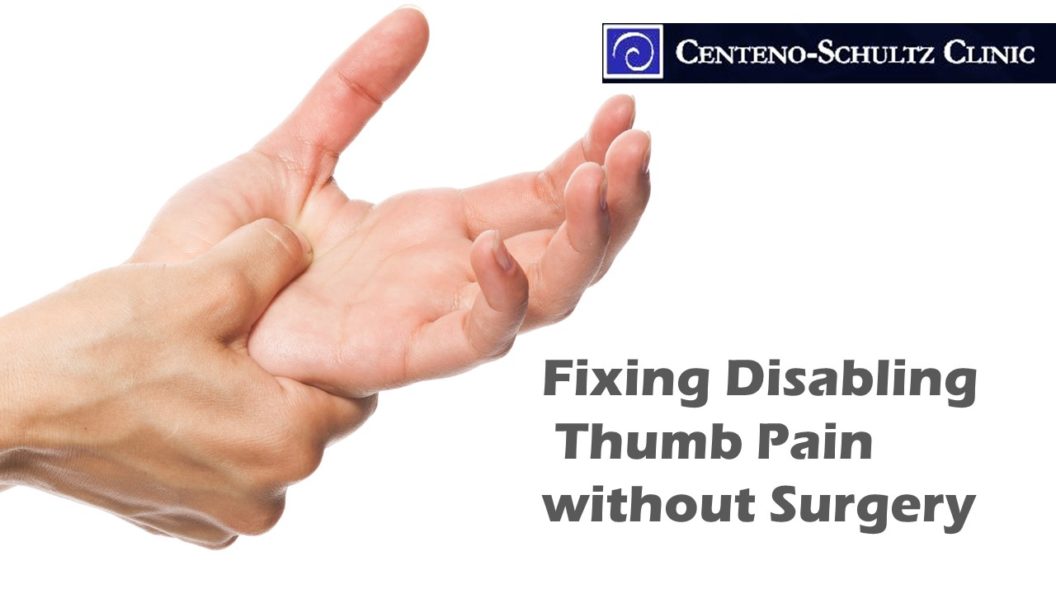In today’s world, driven full speed ahead by instant information on demand, even those of us who’ve spent the majority of our lives in the before-smart-devices era can no longer imagine life without them. Unfortunately, with this new way of high-technology living comes an increase in doctor’s visits for issues that were never a big issue before, and one of those is thumb pain and arthritis. In fact, thumb pain and arthritis have reached epidemic levels, and you can only imagine how much worse it could get as the younger generation who has never known life without an electronic device in their hand, ages.
Unfortunately, the solution to thumb pain and arthritis that isn’t relieved with conservative measures is often surgery. However, in all but the most extreme cases, we give thumb surgery a big thumbs-down. Let’s examine the reasons why.
Thumb Pain and Arthritis May Be Due to a Problem in the Neck
Thumb pain and arthritis aren’t always just about the thumb. The nerves that supply the thumb exit the spinal canal in the cervical region of the spine (or at the neck level). So while we’re using those thumbs and fingers to text and browse, for example, our necks are typically flexed awkwardly downward for long periods of time, placing stress on or damaging the nerves. So, clearly, surgery on the thumb in these cases isn’t going to address the real problem. And the truth is, surgery on the thumb typically on makes matters worse as there’s really no good surgical solution.
Surgeries Performed on the Thumb
Let’s review a few of the surgical solutions for thumb pain and arthritis.
Trapeziectomy and Tendon Interposition
A trapeziectomy is a surgical resection of a bone in the wrist called the trapezium, which forms a portion of the base of the thumb joint. How does cutting out a bone help relieve thumb pain? Good question. The basic thinking is that if the joint hurts, removing it will solve the problem. This, however, presents a different problem: the joint can collapse under the force of the thumb if you just go in and cut out a bone.
The surgical solution? A tendon interposition is sometimes performed following the trapeziectomy. With this surgery, a tendon is removed from the patient’s hand, coiled up, and stuffed into the empty space where the bone used to be. Another option that is sometimes used following a trapeziectomy is a surgery called a tightrope suspensionplasty, which involves drilling a rubber-band type of device through the thumb bone and adjoining structures to attempt to provide support and keep the structures from collapsing into the empty space.
The research is not promising for any these surgeries. Many patients still have thumb pain and loss of mobility in the thumb, and complication rates are very high.
Thumb Joint Fusion or Replacement
Two more-extreme surgery options include a thumb joint fusion or a joint replacement. With a thumb joint fusion, the affected joint is cut out and the ends of the bones are then fused together into one solid piece of bone. Even if this one happens to relieve any pain, it presents a big problem: it eliminates all movement in the joint. Think of how much you move your thumb day in and day out. Making a thumb permanently immobile is a big-thumbs down in our book.
Thumb joint replacement is another thumbs down in most cases. In this case, the joint is removed and replaced with an artificial plastic or metal one. Unfortunately, this one comes with a 40% complication rate and numerous serious side effects, including bone loss.
Risky thumb surgery isn’t the only option for thumb pain and arthritis…
The Interventional Orthopedic Solution for Thumb Pain and Arthritis
Interventional orthopedics (IO) provides a nonsurgical solution for thumb pain and arthritis that focuses on the three factors involved: instability, pain, and function. Orthobiologics, such as the patient’s own concentrated healing growth factors, platelet-rich plasma (PRP), or stem cells, are customized to the condition and location and precisely reinjected using precise advanced image guidance. Strategy one is to treat the joint. Strategy two is to address lax ligaments that have created an unstable joint (or sloppy joint movement). And strategy three is to treat any injured nerve that may be involved in the thumb pain, such as a pinched nerve in the cervical spine.
Watch the Regenexx video below to learn more about thumb arthritis, surgery, and IO solutions.
As with any problem, it’s best to minimize your risk of arthritis with thumb pain, before it becomes an issue. If you perform tasks that require constant repetitive use of the thumb or flexing the neck downward for long periods of time, proactive maintenance now, such a regular chiropractic care to keep everything lined up, is a good idea. If, however, thumb arthritis or more severe and constant thumb pain and functional issues have set in, interventional orthopedics may provide just the right thumbs-up solution for you.

